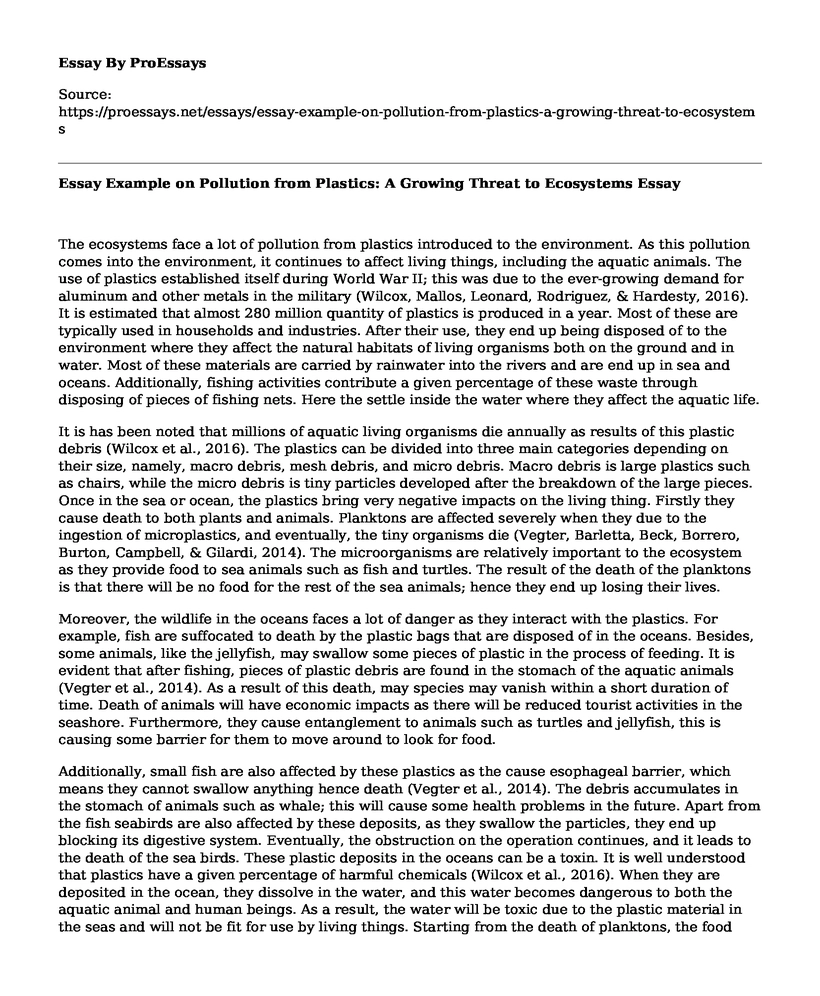The ecosystems face a lot of pollution from plastics introduced to the environment. As this pollution comes into the environment, it continues to affect living things, including the aquatic animals. The use of plastics established itself during World War II; this was due to the ever-growing demand for aluminum and other metals in the military (Wilcox, Mallos, Leonard, Rodriguez, & Hardesty, 2016). It is estimated that almost 280 million quantity of plastics is produced in a year. Most of these are typically used in households and industries. After their use, they end up being disposed of to the environment where they affect the natural habitats of living organisms both on the ground and in water. Most of these materials are carried by rainwater into the rivers and are end up in sea and oceans. Additionally, fishing activities contribute a given percentage of these waste through disposing of pieces of fishing nets. Here the settle inside the water where they affect the aquatic life.
It is has been noted that millions of aquatic living organisms die annually as results of this plastic debris (Wilcox et al., 2016). The plastics can be divided into three main categories depending on their size, namely, macro debris, mesh debris, and micro debris. Macro debris is large plastics such as chairs, while the micro debris is tiny particles developed after the breakdown of the large pieces. Once in the sea or ocean, the plastics bring very negative impacts on the living thing. Firstly they cause death to both plants and animals. Planktons are affected severely when they due to the ingestion of microplastics, and eventually, the tiny organisms die (Vegter, Barletta, Beck, Borrero, Burton, Campbell, & Gilardi, 2014). The microorganisms are relatively important to the ecosystem as they provide food to sea animals such as fish and turtles. The result of the death of the planktons is that there will be no food for the rest of the sea animals; hence they end up losing their lives.
Moreover, the wildlife in the oceans faces a lot of danger as they interact with the plastics. For example, fish are suffocated to death by the plastic bags that are disposed of in the oceans. Besides, some animals, like the jellyfish, may swallow some pieces of plastic in the process of feeding. It is evident that after fishing, pieces of plastic debris are found in the stomach of the aquatic animals (Vegter et al., 2014). As a result of this death, may species may vanish within a short duration of time. Death of animals will have economic impacts as there will be reduced tourist activities in the seashore. Furthermore, they cause entanglement to animals such as turtles and jellyfish, this is causing some barrier for them to move around to look for food.
Additionally, small fish are also affected by these plastics as the cause esophageal barrier, which means they cannot swallow anything hence death (Vegter et al., 2014). The debris accumulates in the stomach of animals such as whale; this will cause some health problems in the future. Apart from the fish seabirds are also affected by these deposits, as they swallow the particles, they end up blocking its digestive system. Eventually, the obstruction on the operation continues, and it leads to the death of the sea birds. These plastic deposits in the oceans can be a toxin. It is well understood that plastics have a given percentage of harmful chemicals (Wilcox et al., 2016). When they are deposited in the ocean, they dissolve in the water, and this water becomes dangerous to both the aquatic animal and human beings. As a result, the water will be toxic due to the plastic material in the seas and will not be fit for use by living things. Starting from the death of planktons, the food web for marine animals will be limited. If the small fish do not find something to eat, they will die, then whales will experience food shortage.
Conclusion
In conclusion, plastic is one of the primary methods of pollution globally. Although the technique can be controlled in various ways, human being happens to be the primary cause of this type of pollution; as a result, they can control it. For example, they may reduce or stop the use of plastic materials even though they are cheap, and the results are costly to human beings and wildlife. Stopping and proper disposal is the only way to prevent the deaths of aquatic animals due to plastic pollution.
References
Eriksen, M., Lebreton, L. C., Carson, H. S., Thiel, M., Moore, C. J., Borerro, J. C., & Reisser, J. (2014). Plastic pollution in the world's oceans: more than 5 trillion plastic pieces weighing over 250,000 tons afloat at sea. PloS one, 9(12), e111913. https://journals.plos.org/plosone/article%3Fid=10.1371/journal.pone.0111913
Vegter, A. C., Barletta, M., Beck, C., Borrero, J., Burton, H., Campbell, M. L., & Gilardi, K. V. (2014). Global research priorities to mitigate plastic pollution impacts on marine wildlife. Endangered Species Research, 25(3), 225-247. https://www.int-res.com/abstracts/esr/v25/n3/p225-247
Wilcox, C., Mallos, N. J., Leonard, G. H., Rodriguez, A., & Hardesty, B. D. (2016). Using expert elicitation to estimate the impacts of plastic pollution on marine wildlife. Marine Policy, 65, 107-114. https://www.sciencedirect.com/science/article/pii/S0308597X15002985
Cite this page
Essay Example on Pollution from Plastics: A Growing Threat to Ecosystems. (2023, May 30). Retrieved from https://proessays.net/essays/essay-example-on-pollution-from-plastics-a-growing-threat-to-ecosystems
If you are the original author of this essay and no longer wish to have it published on the ProEssays website, please click below to request its removal:
- Paper Example on Natural Risks
- Assessing Inter-Sectoral Climate Change Risks: The Role of Isimip
- The Japanese Earthquakes and Tsunami - Paper Example
- Articles Analysis Essay on Pollution in South Asia
- Deforestation: The Impact on Environment & Society - Essay Sample
- Essay Example on Singapore's Solarisation: Public Housing, Floating Solar & More
- Free Essay Example: Recycling in the United States







